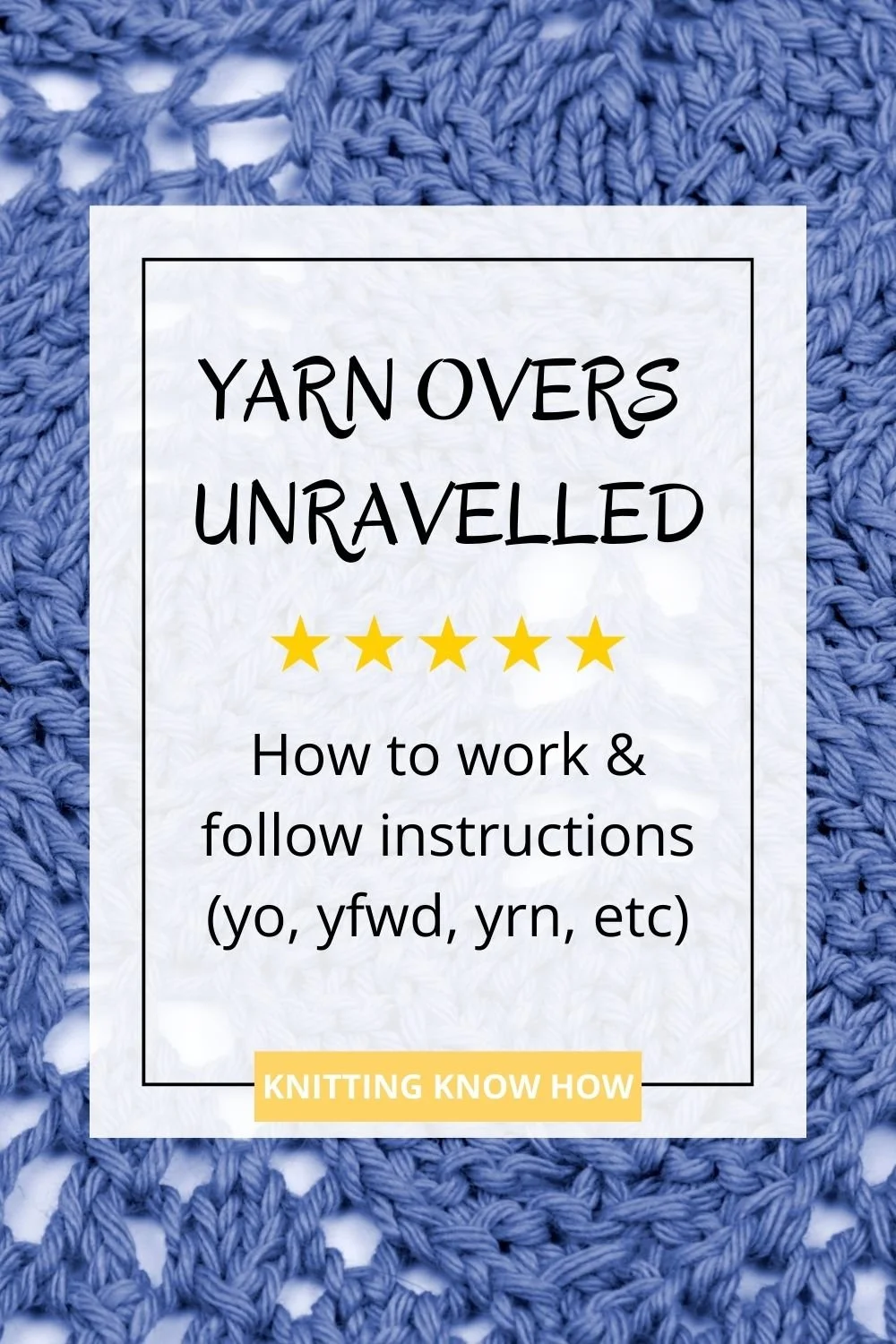Knitting Yarn Overs: How to Work & Follow Instructions (yo, yfwd, yrn, yon etc)
Do you ever find yourself pausing over a pattern because you’re not quite sure what a yarn over is asking you to do? If so, you’re certainly not alone. Many knitters are perfectly happy working the stitch itself, but stumble when faced with the abbreviations. Depending on whether you’re knitting or purling before and after, you’ll see all sorts of different terms: yo, yfwd, yrn, yon, yfrn. No wonder it can feel confusing.
The good news is that yarn overs are one of the simplest stitches you’ll ever work. And once you understand why the instructions look different and what’s actually happening in the fabric, you’ll be able to work them with confidence no matter how they’re written.
In this post (and the video below), we’ll explore:
What a yarn over actually is
Why we use yarn overs in knitting
The common abbreviations and why they differ
Some tips to keep in mind if you’re writing your own patterns
What is a yarn over in knitting?
A yarn over is an increase. You’re creating a brand new loop on the needle by bringing the yarn across in a way that makes it sit as an extra stitch. The defining feature is that the strand of yarn doesn’t come from working into an existing stitch — it’s simply wrapped over the needle and becomes a stitch in its own right.
That’s why yarn overs make a visible hole in the fabric. They’re not twisted or anchored in the same way as a “normal” stitch, so you end up with that deliberate eyelet.
It’s worth remembering: every yarn over adds a stitch. If your pattern is using yarn overs decoratively (for example, in lace), you’ll usually see a corresponding decrease somewhere else in the row to keep the stitch count balanced.
Why do knitters use yarn overs?
Yarn overs are wonderfully versatile. They can be used for:
Eyelet & lace patterns – decorative holes that form motifs and textures.
Increases – sometimes you’ll see them used to shape fabric, such as raglan lines.
functional eyelets or buttonholes – small yarn overs can make neat openings for small buttons or threading ribbon or cord through.
Texture –as well as lace patterns, yarn overs can add interest and lightness in a range of fancy stitch patterns.
In other words, they’re not just about “holes in knitting” — they’re a design tool with lots of creative possibilities.
Why are there different abbreviations for yarn overs?
The stitch itself is always the same idea: bringing the yarn forward and over the needle so it forms a new loop. But how you get there depends on whether you’re knitting or purling before and after. That’s what gives rise to different abbreviations.
Some of the most common are:
yo = yarn over (a general term, most often used in American patterns, and one that works very neatly for continental knitters).
yfwd = yarn forward
yrn – yarn round needle
yon = yarn over needle
yfrn = yarn forward round needle
At first glance they can look like completely different stitches, but they’re really all ways of telling you how to move the yarn depending on the surrounding stitches.
In general, yo tends to be the more modern “catch-all” abbreviation, and you’ll see it used almost universally in US patterns. The others crop up most often in older UK publications and are more geared to English style knitters, where the path of the yarn between knits and purls is described more precisely
🧶 A little history:
Older UK patterns tended to use the more detailed abbreviations (yrn, yfrn, yon, yfwd) because they were written with English style knitting in mind. Writers wanted to describe the exact path of the yarn as it moved between knits and purls.
Meanwhile, US patterns increasingly adopted the simpler catch-all yo, especially as continental knitting grew more common. Over time, that shorter form has become more universal, though you’ll still see the UK terms cropping up in magazines and vintage patterns.
What’s the difference between yrn, yfrn, yon, yfwd?
It all depends on the stitches before and after the yarn over. For example:
Between two knit stitches, you’ll usually see yfwd.
Between a purl and a knit will generally be written as yon.
Between two purl stitches, you’ll see yrn.
Between a Knit and a purl, it’ll usually be written as yfrn.
The key point is: they’re all yarn overs. What changes is the path the yarn has to travel to get into position, because knit and purl stitches start with the yarn at different places in relation to the needles.
How can I make sense of yarn overs without memorising abbreviations?
Instead of trying to memorise what each abbreviation means, focus on what the stitch needs to achieve.
Ask yourself:
Where is my yarn at the moment? (needs to be at the front)
take the yarn over the needle form front to the back.
Where does it need to go for the next stitch? (needs to go back between the needles of to work a purl )
Once you understand that, you can work any yarn over in any situation, no matter what abbreviation a designer has chosen to use.
How do you make yarn overs neat and even?
Be mindful of tension. Some yarn overs naturally make larger holes than others, especially when worked after a purl stitch. If you want them neat and consistent, keep an even tension as you wrap the yarn.
Don’t panic if it looks odd at first. Yarn overs can look messy on the needles, but blocking usually opens them out beautifully.
Working through the back of the stitch above the yarn over on the next but one row (not the first row worked after not) can neaten it up a little.
What should pattern writers consider when using yarn overs?
If you’re writing your own patterns, yarn overs deserve a bit of thought. If you are writing for a publication this will be set put on there house stye sheet which you must adhere to. If you are writing to self publish, then
Choose abbreviations carefully. Think about your audience and be consistent. If you use yo as a catch-all, consider adding a short note in the glossary to explain how to work it depending on the surrounding stitches.
Be consistent - stick to either yo OR the English style yfwd, yrn etc (never both) throughout your pattern, and ideally across all your patterns.
Add this to your own style sheet, so you remember what your chosen approach is. This will help with being consistent, and is good to share with your tech editor.
Good instructions can make the difference between a knitter feeling confident or giving up on a pattern, so it’s worth spending time getting them right.
Watch the video
I talk through all of this — and show you how the stitches look on the needles — in the video below.
👉 Watch here:
Final thoughts: are yarn overs really that complicated?
Not at all. At heart, they’re one of the simplest stitches in knitting — just a strand wrapped over the needle. What makes them tricky is the variety of abbreviations and the way different designers choose to write them.
By understanding what’s happening on our needles, rather than relying on memorising abbreviations, you’ll be able to work yarn overs confidently in any pattern. Whether you’re tackling lace for the first time, adding buttonholes, or writing your own designs, they’re a versatile tool that opens up all sorts of creative possibilities.
So next time you see yo yfwd, yrn, yon or yfrn in a pattern, you’ll know exactly what’s going on.
Happy Creating!
PS - If you’d like me to let you know of new posts or updates, please consider signing up to my email list below.


